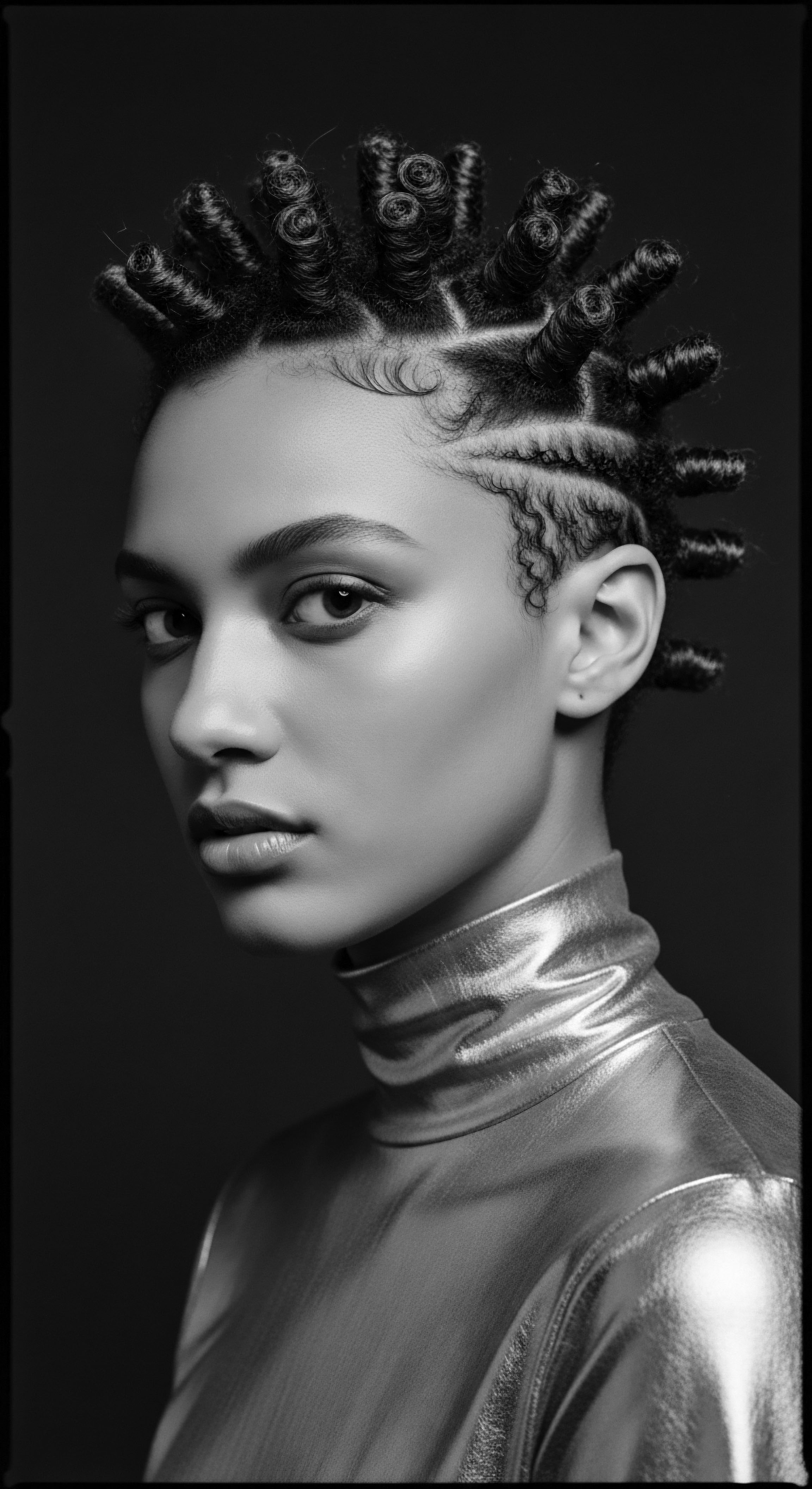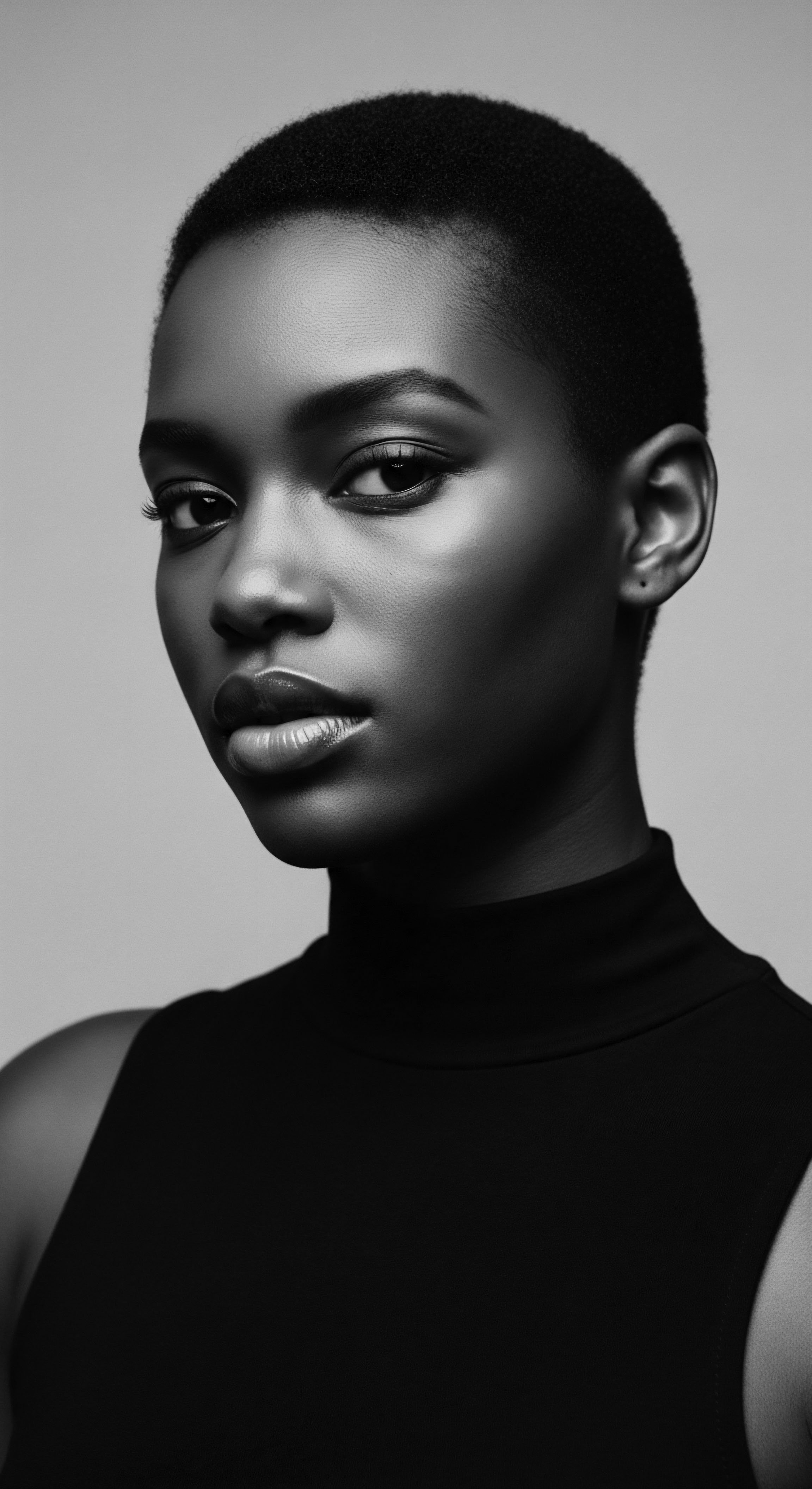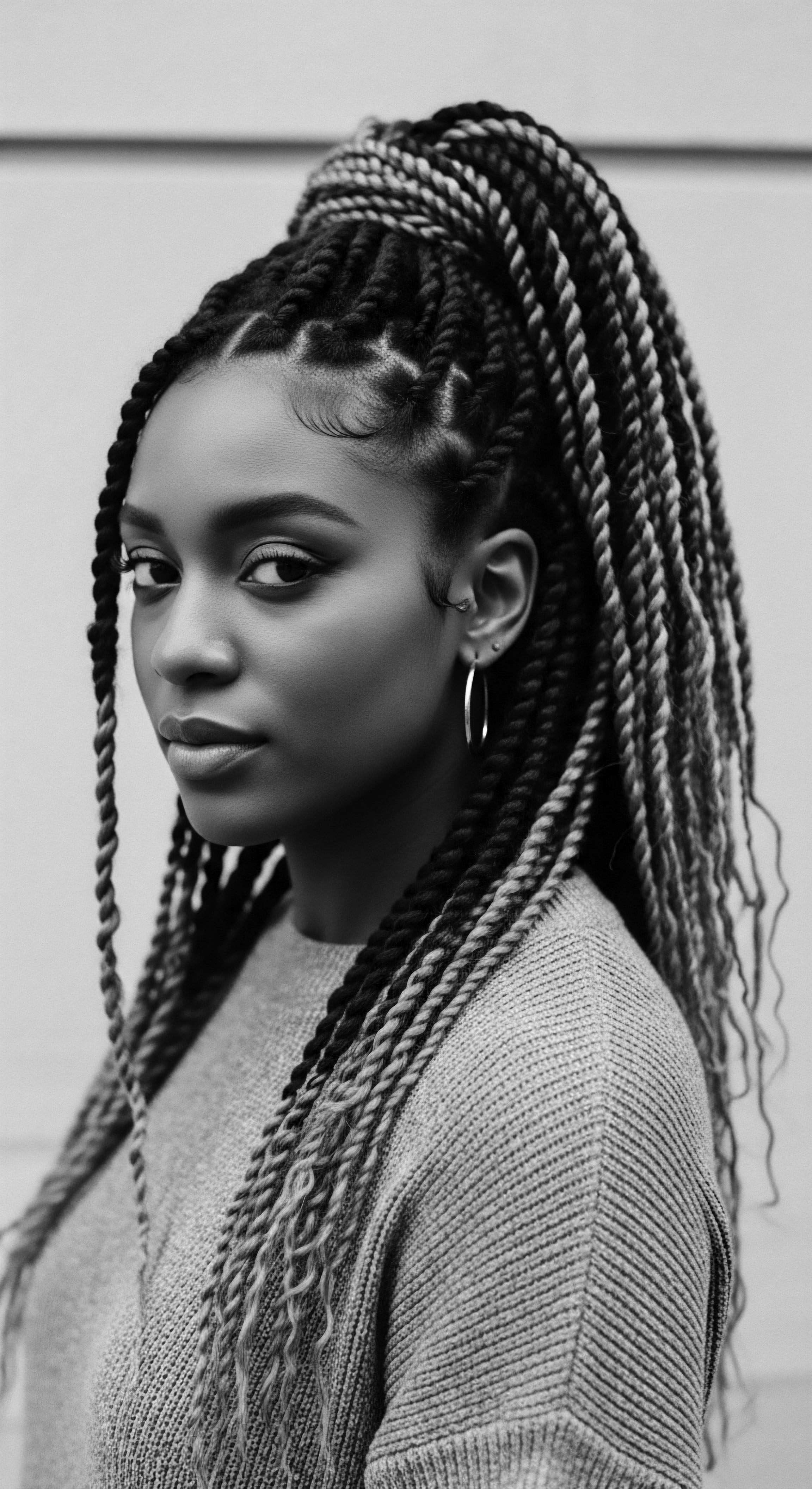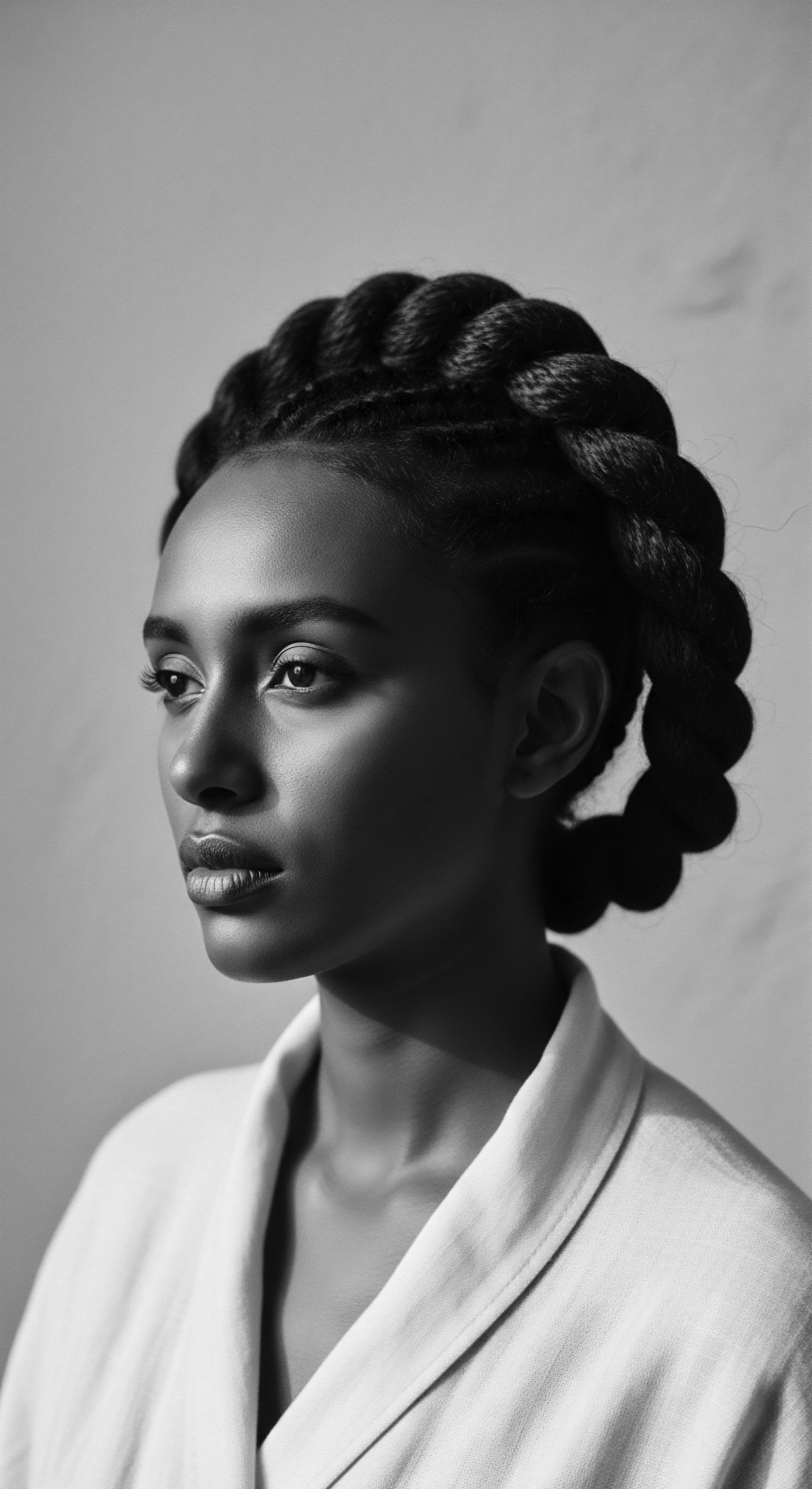
Fundamentals
The concept of the Chemical Relaxer, at its most elemental, describes a process of intentionally altering the inherent curl pattern of hair through the application of chemical agents. This definition, while seemingly straightforward, carries within its delineation a profound cultural and historical weight, especially when considering textured hair. A Chemical Relaxer serves as a transformative compound, meticulously formulated to rearrange the protein bonds within the hair shaft, thereby reducing the natural curl and imparting a smoother, straighter appearance. Its explication extends beyond mere chemical reactions; it delves into the deeply personal choices individuals make about their hair, often influenced by centuries of shared heritage and societal perceptions.
The journey of hair, a living fiber, has always been intertwined with human expression, communal rituals, and the marking of identity. From the earliest whispers of ancestral practices, humanity has sought to adorn, protect, and reshape hair, understanding its deep significance. Before the advent of modern chemical interventions, communities across the globe, particularly those with highly coiled or kinky hair, developed sophisticated methods to manage and style their tresses. These traditional approaches, often rooted in available natural resources and collective wisdom, laid a foundation for the continuous human endeavor to shape hair’s physical manifestation.
Chemical relaxers represent a deliberate chemical alteration of hair’s natural curl, a practice with deep roots in the historical and cultural quest for specific hair aesthetics across textured hair communities.

Echoes from the Source ❉ Early Forms of Hair Alteration
Long before the precise chemical formulations of contemporary relaxers, ancestral communities engaged in various forms of hair alteration, driven by practical needs, spiritual beliefs, and aesthetic desires. These methods were not about permanent chemical restructuring but rather about temporary straightening, elongation, or enhanced manageability. Ancient African civilizations, for example, revered hair as a conduit to the divine and a symbol of status, identity, and tribal affiliation. Hairstyles communicated age, marital status, and even religious adherence.
Traditional practices for textured hair often involved a careful blend of natural ingredients and physical manipulation. Shea butter, various plant oils, and clays served as conditioners and styling aids, providing moisture and protection. Combing, braiding, and knotting techniques, passed down through generations, helped to stretch and organize hair, creating styles that were both functional and symbolic.
For instance, cornrows, intricate braids plaited close to the scalp, could form geometric or symbolic patterns and were worn by individuals of diverse cultures, including the Ewe, Ashanti, Igbo, and Yoruba. These ancient methods highlight a profound, ongoing dialogue between humans and their hair, a conversation shaped by environmental realities and cultural aspirations.

The Genesis of Modern Relaxers
The late 19th and early 20th centuries witnessed a significant shift in hair care, particularly within Black communities in the diaspora. Societal pressures to conform to Eurocentric beauty standards began to exert a powerful influence, linking perceived professionalism and attractiveness with straighter hair textures. This period saw the popularization of hot combs, a tool that, while effective for temporary straightening, often caused damage. The demand for more enduring solutions grew, paving the way for chemical interventions.
The documented history of the modern chemical relaxer traces back to the early 20th century. Garrett Augustus Morgan, a notable African American inventor, made a significant contribution. In 1909, while working on a solution to reduce friction on sewing machine needles, he observed that a chemical cream he was developing could also straighten fibers. This accidental discovery led him to test the cream on a neighboring dog’s fur, and with its success, he established the G.A.
Morgan Hair Refining Company. His hair straightening product, launched around 1913, marked a pivotal moment, offering a chemical means to alter hair texture. This early product, and others that followed, were marketed to Black people, reflecting a burgeoning industry aimed at addressing specific hair needs within the community.

Intermediate
The Chemical Relaxer, at an intermediate level of understanding, is not merely a product but a chemical system designed to fundamentally alter the protein structure of hair. Its functional significance lies in its capacity to disrupt the natural architecture of the hair fiber, particularly the robust disulfide bonds that confer curl and strength to textured hair. This chemical modification yields a smoother, more elongated strand, which is then easier to comb and style in ways that might deviate from its original coiled configuration. The underlying intention of this process often involves a desire for a particular aesthetic or ease of maintenance, yet its broader cultural implications, especially for Black and mixed-race individuals, remain deeply layered.
Understanding the Chemical Relaxer requires an appreciation of its journey from a laboratory concept to a widespread cultural practice. The initial formulations, though revolutionary for their time, were often harsh. As the decades unfolded, scientific advancements allowed for variations in chemical composition, seeking to balance efficacy with reduced damage. These developments, however, always occurred within a societal context where hair, especially textured hair, held significant social currency.

The Science of Straightening ❉ Breaking Bonds
Hair is primarily composed of a protein called Keratin, arranged in intricate helical structures. These keratin molecules are held together by various bonds, with Disulfide Bonds playing a particularly crucial role in determining hair’s natural shape and resilience. These strong chemical linkages, formed between two cysteine amino acid residues, create cross-links that give hair its inherent curl and strength. To straighten hair, these disulfide bonds must be broken.
Chemical relaxers achieve this by employing strong alkaline agents. Historically, and still commonly, this involves Sodium Hydroxide, also known as lye. When a lye-based relaxer is applied, its highly alkaline nature causes the hair shaft to swell and the cuticle to open, allowing the active chemicals to penetrate the cortex.
The hydroxide ions then react with the disulfide bonds, removing one of the sulfur atoms and converting the bond into a more flexible Lanthionine Bond. This process, known as lanthionization, permanently breaks the original disulfide bond, preventing it from reforming in its previous curly configuration.
Later innovations brought about “no-lye” relaxers, often utilizing guanidine hydroxide, potassium hydroxide, or lithium hydroxide. While these formulations are generally considered less harsh than lye relaxers, they still operate on the principle of breaking and reforming bonds to achieve straightening. They often require a separate activator and can still cause significant scalp irritation and hair damage if not applied correctly.

The Social Fabric ❉ Relaxers and Identity
The widespread adoption of chemical relaxers within Black and mixed-race communities cannot be separated from the prevailing societal norms and beauty standards that often privileged straighter hair textures. During the early to mid-20th century, and for many decades thereafter, relaxed hair became a common practice, viewed by some as a means of assimilation or a necessity for professional and social acceptance. This phenomenon was not simply a personal aesthetic choice; it reflected a complex interplay of systemic pressures and individual agency.
Hair became a visible marker in a society grappling with racial hierarchies. Straightened hair could signify a certain perceived level of refinement or conformity to dominant ideals. This perspective, though rooted in oppressive historical contexts, led many to view relaxers as a tool for navigating a world that often discriminated against natural textured hair. Magazines and beauty product manufacturers also played a role, frequently promoting images of straightened hair, which subtly reinforced these societal expectations.
The chemical alteration of hair through relaxers became a complex practice, intertwining scientific processes with profound societal pressures and personal identity choices within Black and mixed-race communities.

The Diaspora’s Choice ❉ Regional Variations and Evolving Perceptions
The narrative of chemical relaxers extends across the African diaspora, with varying degrees of adoption and evolving perceptions. In communities across the Americas, Europe, and even parts of Africa, relaxers became a common hair care staple. This global reach highlights a shared experience of navigating beauty standards that often diverged from inherent hair textures.
The reasons for choosing relaxers were multifaceted. For some, it offered ease of management and styling versatility in a practical sense. For others, it represented a strategic response to societal biases.
Over time, as natural hair movements gained momentum, particularly from the 1960s onwards, a counter-narrative began to strengthen, challenging the notion that straightened hair was the sole or superior standard of beauty. This shift, rooted in pride and a reclamation of ancestral aesthetics, has prompted a re-evaluation of the relaxer’s place in the hair care lexicon.
Here is a brief comparison of how hair straightening methods have evolved ❉
| Method Category Primary Mechanism |
| Traditional/Ancestral Approaches Physical manipulation, natural emollients, heat from natural sources (e.g. heated stones, pressing combs). |
| Early Chemical Relaxers (20th Century) Chemical disruption of hair's internal protein bonds (disulfide bonds). |
| Method Category Ingredients/Tools |
| Traditional/Ancestral Approaches Clays, plant oils (shea butter, coconut oil), herbs, combs made from wood or bone, heated implements. |
| Early Chemical Relaxers (20th Century) Alkaline compounds (sodium hydroxide, later guanidine hydroxide), petroleum jelly, mineral oil. |
| Method Category Longevity of Effect |
| Traditional/Ancestral Approaches Temporary; effects reversed by moisture or washing. |
| Early Chemical Relaxers (20th Century) Permanent alteration of the treated hair; new growth requires re-application. |
| Method Category Cultural Context |
| Traditional/Ancestral Approaches Integral to social status, identity, spiritual practices, communal grooming rituals. |
| Early Chemical Relaxers (20th Century) Response to Eurocentric beauty standards, quest for manageability, economic necessity in some contexts. |
| Method Category The journey from ancestral hair care to chemical relaxers reflects humanity's continuous efforts to shape hair, a profound cultural artifact. |

Academic
The Chemical Relaxer, within an academic discourse, constitutes a potent chemical agent designed to induce a permanent conformational change in the keratinous structure of hair, primarily targeting the disulfide bonds that underpin its natural helical and coiled morphology. This process, termed Lanthionization when hydroxide-based relaxers are employed, involves the irreversible cleavage of cystine disulfide bonds, leading to the formation of a single sulfur lanthionine bond. The profound chemical modification yields a straightened or significantly loosened hair fiber, a transformation with extensive ramifications that extend beyond mere cosmetic alteration into the complex domains of sociology, public health, and the cultural politics of identity. The meaning of this product, therefore, transcends its chemical formulation, becoming a lens through which to examine historical power dynamics, aesthetic assimilation, and the enduring resilience of textured hair heritage.
A rigorous examination of the Chemical Relaxer necessitates an interdisciplinary approach, drawing from organic chemistry to comprehend its molecular action, from anthropology to trace its cultural adoption, and from public health research to assess its physiological impacts. This holistic perspective reveals the intricate layers of significance embedded within a product that has shaped, and continues to shape, the lived experiences of millions globally.

The Molecular Choreography ❉ A Deeper Examination
The structural integrity of hair, particularly its characteristic curl patterns, is primarily attributable to the numerous disulfide bonds present within the keratin protein matrix of the cortex. These covalent bonds impart significant tensile strength and elasticity to the hair shaft. Chemical relaxers, particularly those employing highly alkaline active ingredients such as sodium hydroxide (lye) or guanidine hydroxide (no-lye), function by facilitating a chemical reaction that irrevocably alters these bonds.
The hydroxide ions from the relaxer solution instigate a nucleophilic attack on the sulfur atoms within the disulfide bonds. This reaction sequence leads to the elimination of one sulfur atom from the cystine linkage, resulting in the formation of a Lanthionine Bond. The lanthionine bond, possessing only one sulfur atom, is chemically distinct from the original disulfide bond and cannot reform into the original coiled configuration. This irreversible structural change allows the hair to be mechanically straightened during the relaxing process.
While thio-based relaxers (which are less common for textured hair straightening than for perming) break disulfide bonds via reduction and then reform them through oxidation, hydroxide relaxers permanently break and convert these bonds, rendering them unreformable. The extreme alkalinity of these products, often with pH levels ranging from 12 to 14, explains their corrosive potential and the need for meticulous application to mitigate scalp burns and hair damage.

Sociological Echoes ❉ Hair, Power, and the Quest for Belonging
The sociological significance of chemical relaxers within Black and mixed-race communities is profound, reflecting a complex interplay of historical subjugation, aspirational identity, and economic realities. Hair, as a highly visible aspect of identity, became a battleground for racial politics following the transatlantic slave trade. Enslaved Africans, stripped of their traditional hair care tools and practices, faced immense pressure to conform to European beauty standards, which deemed their natural hair undesirable. This historical devaluation laid the groundwork for a societal landscape where straightened hair was often perceived as more “professional,” “neat,” or “acceptable” in dominant white spaces.
A 2020 research study on natural hair in the job recruitment process illuminates this enduring bias. It found that Black women with natural hairstyles were “perceived to be less professional, less competent, and less likely to be recommended for a job interview” compared to Black women with straightened hair or white women with either curly or straight hair. This finding underscores the systemic pressures that historically, and in many instances still today, compelled Black women to chemically alter their hair for social and economic self-preservation, rather than solely from a desire for self-hatred or emulation. The decision to relax hair, therefore, often represented a strategic adaptation to societal expectations, a nuanced choice within a constrained environment.

Ancestral Memory and Modern Choice ❉ Reconciling Past and Present
The discourse surrounding chemical relaxers today is deeply intertwined with the resurgence of the natural hair movement, a powerful cultural shift that seeks to reclaim and celebrate the inherent beauty of textured hair. This movement is not simply a trend; it is a profound act of ancestral remembrance and cultural affirmation. It encourages individuals to connect with their roots, challenging the Eurocentric beauty ideals that once dictated hair choices. The journey away from relaxers for many is a journey back to self, a recognition of the inherent beauty and versatility of their natural coils and kinks.
Despite this shift, the legacy of chemical relaxers continues to shape hair care practices and conversations. The historical context of their widespread use, coupled with emerging health concerns, necessitates a careful re-evaluation. Recent studies have highlighted potential health risks associated with chemical relaxers, including links to hormone-sensitive cancers such as uterine, ovarian, and endometrial cancers. For instance, a study from Boston University’s Black Women’s Health Study (BWHS) reported that long-term use of chemical hair relaxers by postmenopausal Black women was associated with an increased risk of uterine cancer.
Those who used relaxers more than twice a year or for over five years showed a greater than 50% increased risk. These findings, while requiring further investigation, add another layer of complexity to the meaning of chemical relaxers, shifting the focus from purely aesthetic or social utility to public health and wellness.
Academic analysis of chemical relaxers reveals a complex interaction between their molecular action on hair, the pervasive sociological pressures for conformity, and contemporary public health concerns, all viewed through the enduring lens of textured hair heritage.

A Historical Lens ❉ Garrett Augustus Morgan’s Innovation and Its Context
The historical trajectory of the chemical relaxer in the United States is intrinsically linked to the ingenuity of Black inventors and entrepreneurs who sought to address the specific hair care needs of their community within a racially stratified society. While the concept of hair straightening had existed in various forms, the development of a chemical solution that could permanently alter hair texture was a significant advancement.
One compelling example, often overshadowed by other narratives, is the contribution of Garrett Augustus Morgan. Born in 1877 to formerly enslaved parents, Morgan was a prolific inventor who sought practical solutions to everyday problems. His journey into hair care began not in a beauty salon, but in his tailoring shop. In 1909, while experimenting with a chemical solution to reduce friction and prevent scorching on sewing machine needles, he observed that the liquid also had a remarkable effect on the woolen fabric fibers, causing them to straighten.
This accidental discovery led Morgan to apply the solution to a neighboring dog’s fur, and witnessing its straightening effect, he then tested it on his own hair. The success of this experiment prompted him to establish the G.A. Morgan Hair Refining Company, launching his hair straightening product around 1913. Morgan’s product, often referred to as “G.A.
Morgan’s Hair Refiner,” was among the earliest commercially available chemical relaxers. This invention, while less celebrated than his traffic signal or gas mask, represents a crucial moment in the history of Black hair care. It illustrates the innovative spirit within the Black community to create products tailored to their unique hair textures, even as they navigated a society that often imposed rigid beauty standards. Morgan’s work, therefore, stands as a testament to the intersection of scientific curiosity, entrepreneurial drive, and the deep cultural context of hair practices within the African diaspora.
The adoption of chemical relaxers became a widespread phenomenon, influenced by a complex web of factors. These included the desire for manageability, the pursuit of perceived aesthetic ideals, and the very real pressures of racial discrimination in employment and social settings. The availability of products like Morgan’s provided a means for individuals to conform, even if it meant compromising the natural state of their hair. The choice to relax hair was rarely simple, often balancing personal preference with external expectations.
Here is a breakdown of the types of chemical relaxers and their primary chemical agents ❉
- Lye Relaxers (Sodium Hydroxide) ❉ These are the most potent type, containing sodium hydroxide (NaOH) as the active ingredient. They operate at a very high pH, typically above 12, and are known for their effectiveness in achieving significant straightening. Sodium hydroxide relaxers permanently break disulfide bonds via lanthionization.
- No-Lye Relaxers (Guanidine Hydroxide, Etc.) ❉ These formulations use active ingredients such as guanidine hydroxide, potassium hydroxide, or lithium hydroxide. While still highly alkaline, they are generally considered less caustic than lye relaxers. They require a separate activator and create lanthionine bonds, similar to lye relaxers, but through a slightly different chemical pathway.
- Thio Relaxers (Ammonium Thioglycolate) ❉ Less common for permanent straightening of highly coiled hair, these relaxers (often used in perms to create curl) use ammonium thioglycolate. They break disulfide bonds through a reduction reaction, which are then reformed in the new shape using a neutralizer (oxidizing agent). Hydroxide-treated hair is incompatible with thio relaxers due to the irreversible nature of lanthionine bonds.
The ongoing dialogue around chemical relaxers today encompasses both the historical context of their development and use, as well as the contemporary understanding of their effects on hair health and overall well-being. This multifaceted perspective underscores the deep connection between hair care practices, personal identity, and the broader tapestry of cultural heritage.
| Relaxer Type Lye Relaxers |
| Primary Chemical Agent Sodium Hydroxide (NaOH) |
| Mechanism of Action Irreversibly breaks disulfide bonds via lanthionization, removing a sulfur atom and forming a lanthionine bond. |
| Historical/Cultural Significance Early commercial formulations, highly effective for significant straightening; became a staple in Black hair care, often associated with achieving Eurocentric beauty standards. |
| Relaxer Type No-Lye Relaxers |
| Primary Chemical Agent Guanidine Hydroxide, Potassium Hydroxide, Lithium Hydroxide |
| Mechanism of Action Breaks disulfide bonds and forms lanthionine bonds, generally considered less irritating to the scalp than lye, but still highly alkaline. |
| Historical/Cultural Significance Introduced as a "gentler" alternative, gaining popularity in the mid-20th century. Offered a perceived safer option while still delivering desired straightening. |
| Relaxer Type Thio Relaxers |
| Primary Chemical Agent Ammonium Thioglycolate |
| Mechanism of Action Breaks disulfide bonds through reduction, then reforms them in a new configuration using an oxidizing neutralizer. |
| Historical/Cultural Significance Primarily used for perming (adding curl) in many hair types; less common for the intense straightening of highly coiled hair, and incompatible with hydroxide-treated hair. |
| Relaxer Type The evolution of relaxer chemistry reflects both scientific advancement and a continuous response to cultural demands and perceived needs within textured hair communities. |

Reflection on the Heritage of Chemical Relaxers
The journey of the Chemical Relaxer, from its rudimentary origins to its complex modern iterations, stands as a testament to the enduring human desire for self-expression through hair. This journey is particularly poignant within the context of textured hair heritage, where the choices made about hair have always been deeply intertwined with identity, resilience, and the navigation of societal landscapes. The story of relaxers is not simply one of chemistry; it is a narrative steeped in the Soul of a Strand, reflecting generations of adaptation, innovation, and profound cultural negotiation.
Each coil and curl carries within it the echoes of ancestral wisdom, of hands that braided, oiled, and adorned hair not merely for aesthetics but for communication, spiritual connection, and community building. The advent of chemical relaxers introduced a new chapter, one that, while offering a pathway to conformity in a world that often demanded it, also sparked a continuous dialogue about authenticity, self-acceptance, and the very definition of beauty. We observe how the scientific understanding of hair’s molecular structure allowed for transformations previously unimaginable, yet these transformations were always filtered through the living traditions of care and the collective experiences of Black and mixed-race communities.
Today, as the natural hair movement gains momentum, a vibrant reclamation of inherent texture is unfolding. This does not erase the historical significance of the relaxer but rather places it within a broader, more nuanced understanding of hair’s journey. The Chemical Relaxer, therefore, serves as a powerful artifact in Roothea’s living library, a reminder of the paths taken, the choices made, and the continuous striving for self-determination that characterizes the heritage of textured hair. The unbound helix, in its myriad forms, whether chemically altered or vibrantly natural, continues to voice identity and shape futures, carrying forward the rich legacy of those who came before.

References
- Abdullah, M. (1998). The politics of black women’s hair. Black Women in America ❉ An Historical Encyclopedia.
- Banks, I. (2000). Hair Matters ❉ Beauty, Power, and Black Women’s Consciousness. New York University Press.
- Berry, B. (2008). Black Hair ❉ Art, Culture, and History. Book Builders.
- Brinton, L. A. et al. (2020). Hair relaxer use and breast cancer risk in the Ghana Breast Health Study. International Journal of Cancer.
- Caldwell, K. L. (2003). ‘Look at Her Hair’ ❉ The Body Politics of Black Womanhood in Brazil. Transforming Anthropology.
- Llanos, A. A. et al. (2017). Hair product use and breast cancer risk in the Women’s Circle of Health Study. Carcinogenesis.
- Malone, A. (2000). Madam C.J. Walker ❉ The Making of an American Icon. University of Illinois Press.
- Morgan, G. A. (1923). Traffic Signal. U.S. Patent No. 1,475,024.
- Oforiwa, A. (2023). The History and Culture of African Natural Hair ❉ From Ancient Times to Modern Trends. AMAKA Studio.
- Rosado, S. (2003). Braids, Locks, and Twists ❉ The Grammar of African American Hair. Journal of Black Studies.
- Tharps, L. & Byrd, A. (2001). Hair Story ❉ Untangling the Roots of Black Hair in America. St. Martin’s Press.
- Thompson, C. (2009). Black Women and the Politics of Hair. The Feminist Review.
- Wise, L. A. et al. (2020). Hair relaxer use and risk of uterine leiomyomata in the Black Women’s Health Study. American Journal of Epidemiology.
